Skyhook-Based Techniques for Vehicle Suspension Control: A Review of the State of the Art
Abstract
1. Introduction
2. Skyhook Controllers
2.1. Classical Skyhook Controllers
2.1.1. Skyhook Damping
2.1.2. Skyhook Inertance
2.2. Improved Skyhook Controllers
2.3. Conclusions on Skyhook Control
3. Groundhook and Hybrid Controllers
3.1. Groundhook Controllers
3.1.1. Groundhook Control Proposed by Valášek
3.1.2. Groundhook Control Proposed by Paré
3.2. Hybrid Controllers
3.2.1. Classical Hybrid Controllers
3.2.2. Improved Hybrid Control
3.3. Conclusions on Groundhook and Hybrid Control
4. Actuator for Skyhook-Based Control
4.1. Hydraulic Actuators
4.2. Electromagnetic Actuators
4.3. MR/ER Fluid Actuator
| Type | Prototype | Reference |
|---|---|---|
| Electronically adjustable dampers |  | [ThyssenKrupp. DampTronic®, online] |
| Fluid inerter integrated with shock absorber |  | Ref. [53], Figure 8 |
| A new adjustable device combining an inerter and a damper |  | Ref. [92], Figure 2 |
| Prototype electromagnetic (EM) linear actuator | 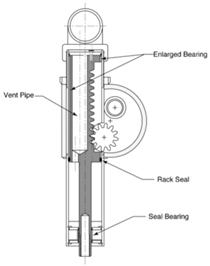 | Ref. [94], Figure 9 |
| The MRF bypass damper |  | Ref. [108], Figure 20 |
| ER damper | 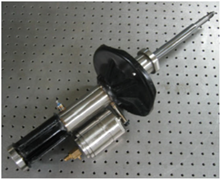 | Ref. [109], Figure 1 |
| MR damper with negative stiffness component |  | Ref. [107], Figure 1 |
5. Industrial Implementation and Development Trends in Skyhook-Based Control
5.1. Industrial Implementation
5.2. Development Trends of Skyhook-Based Control
5.2.1. Collaborative Optimization of Multiple Control Methods
5.2.2. Data-Driven Optimization and Model Accuracy Improvement
5.2.3. Expansion of Application Fields
6. Conclusions
- (1)
- The Skyhook theory is a suspension control strategy which aims at improving the comfort of riding; such controllers can be classified as classical Skyhook controllers or improved Skyhook controllers. Skyhook-based control is distinguished by its clear logic and computational simplicity. With the development of sliding mode control, fuzzy logic, and machine learning, Skyhook-based control is combined with these new theories to achieve better ride comfort.
- (2)
- Groundhook control is oriented to vehicle handling stability, and hybrid control is mainly used to balance the contradiction between ride comfort and handling stability of vehicle suspension. In this paper, the concepts of Groundhook control and hybrid control, as well as related improved models, are analyzed and discussed in detail.
- (3)
- Suspension actuators have been improved and upgraded based on the development of the hydraulic industry, electromagnetic industry, and MR/ER fluid industry. Many different kinds of actuator have been designed and analyzed to address the contradiction between ride comfort and handling performance in vehicle suspensions.
- (4)
- There are some essential problems and challenges that need to be further investigated. Future research should focus on integrating Skyhook-based control with other algorithms to achieve smoother and more consistent ride quality. Furthermore, Skyhook-based control shows potential for application in other industrial fields.
Author Contributions
Funding
Data Availability Statement
Acknowledgments
Conflicts of Interest
References
- Chen, Y.X.; Chen, L.; Wang, R.C.; Xu, X.; Shen, Y.J.; Liu, Y.L. Modeling and test on height adjustment system of electrically-controlled air suspension for agricultural vehicles. Int. J. Agric. Biol. Eng. 2016, 9, 40–47. [Google Scholar] [CrossRef]
- Wang, X.; Hong, T.; Fang, W.; Chen, X. Optimized Design for Vibration Reduction in a Residual Film Recovery Machine Frame Based on Modal Analysis. Agriculture 2024, 14, 543. [Google Scholar] [CrossRef]
- Cui, L.; Xue, X.; Le, F.; Mao, H.; Ding, S. Design and experiment of electro hydraulic active suspension for controlling the rolling motion of spray boom. Int. J. Agric. Biol. Eng. 2019, 12, 72–81. [Google Scholar] [CrossRef]
- Venhovens, P.T. The development and implementation of adaptive semi-active suspension control. Veh. Syst. Dyn. 1994, 23, 211–235. [Google Scholar] [CrossRef]
- Popp, K.; Schiehlen, W. Ground Vehicle Dynamics; Springer Science & Business Media: Berlin/Heidelberg, Germany, 2010. [Google Scholar]
- Pacejka, H. Tire and Vehicle Dynamics; Elsevier: Amsterdam, The Netherlands, 2005. [Google Scholar]
- Gao, Y.; Yang, Y.; Fu, S.; Feng, K.; Han, X.; Hu, Y.; Zhu, Q.; Wei, X. Analysis of vibration characteristics of tractor–rotary cultivator combination based on time domain and frequency domain. Agriculture 2024, 14, 1139. [Google Scholar] [CrossRef]
- Chen, S.; Zhou, Y.; Tang, Z.; Lu, S. Modal vibration response of rice combine harvester frame under multi-source excitation. Biosyst. Eng. 2020, 194, 177–195. [Google Scholar] [CrossRef]
- Crosby, M.; Karnopp, D.C. The active damper: A new concept for shock and vibration control. Shock Vib. Bull. 1973, 43, 119–133. [Google Scholar]
- Hidaka, S.; Ahn, Y.K.; Morishita, S. Adaptive vibration control by a variable-damping dynamic absorber using ER fluid. J. Vib. Acoust. 1999, 121, 373–378. [Google Scholar] [CrossRef]
- Yu, F.; Zhang, Y.; Zhang, G. Review on vehicle electromagnetic suspension technology. Automot. Eng. 2012, 34, 569–574. [Google Scholar]
- Isa, H.M.; Mahadi, W.N.L.; Ramli, R.; Abidin, M.A. A review on electromagnetic suspension systems for passenger vehicle. In Proceedings of the International Conference on Electrical, Control and Computer Engineering 2011 (InECCE), Pahang, Malaysia, 21–22 June 2011; IEEE: New York, NY, USA, 2011; pp. 399–403. [Google Scholar]
- Zhu, Y.; Cui, B.; Yu, Z.; Gao, Y.; Wei, X. Tillage Depth Detection and Control Based on Attitude Estimation and Online Calibration of Model Parameters. Agriculture 2024, 14, 2130. [Google Scholar] [CrossRef]
- Xu, L.; Chai, X.; Gao, Z.; Li, Y.; Wang, Y. Experimental study on driver seat vibration characteristics of crawler-type combine harvester. Int. J. Agric. Biol. Eng. 2019, 12, 90–97. [Google Scholar] [CrossRef]
- Pang, J.; Li, Y.; Ji, J.; Xu, L. Vibration excitation identification and control of the cutter of a combine harvester using triaxial accelerometers and partial coherence sorting. Biosyst. Eng. 2019, 185, 25–34. [Google Scholar] [CrossRef]
- Hu, Y.; Chen, M.Z.; Sun, Y. Comfort-oriented vehicle suspension design with skyhook inerter configuration. J. Sound Vib. 2017, 405, 34–47. [Google Scholar] [CrossRef]
- Shafiei, B. A review on PID control system simulation of the active suspension system of a quarter car model while hitting road bumps. J. Inst. Eng. (India) Ser. C 2022, 103, 1001–1011. [Google Scholar] [CrossRef]
- Harly, M. Model of Integrated of Car Brake-Active Suspension of Quarter Car Model By Using LQR Control Under Periodic Road Excitation. IOP Conf. Ser. Mater. Sci. Eng. 2021, 1152, 012023. [Google Scholar] [CrossRef]
- Gu, S.; Zhang, J. Variable gain ADRC for delta parallel manipulators with disturbances. Control Eng. Pract. 2024, 145, 105877. [Google Scholar] [CrossRef]
- Zhang, S.; Xue, X.; Chen, C.; Sun, Z.; Sun, T. Development of a low-cost quadrotor UAV based on ADRC for agricultural remote sensing. Int. J. Agric. Biol. Eng. 2019, 12, 82–87. [Google Scholar] [CrossRef]
- Liu, H.; Yan, S.; Shen, Y.; Li, C.; Zhang, Y.; Hussain, F. Model predictive control system based on direct yaw moment control for 4WID self-steering agriculture vehicle. Int. J. Agric. Biol. Eng. 2021, 14, 175–181. [Google Scholar] [CrossRef]
- Lu, E.; Xue, J.; Chen, T.; Jiang, S. Robust trajectory tracking control of an autonomous tractor-trailer considering model parameter uncertainties and disturbances. Agriculture 2023, 13, 869. [Google Scholar] [CrossRef]
- Liao, Y.; Ning, D.; Du, H. Infinite horizon one-step MPC with linearised constraints for electrically interconnected suspension system. Mech. Syst. Signal Process. 2025, 229, 112521. [Google Scholar] [CrossRef]
- Tang, L.; Ren, N.L.; Funkhouser, S. Semi-active suspension control with PSO tuned LQR controller based on MR damper. Int. J. Automot. Mech. Eng. 2023, 20, 10512–10522. [Google Scholar] [CrossRef]
- Ding, Z.; Tang, Z.; Zhang, B.; Ding, Z. Vibration Response of Metal Plate and Shell Structure under Multi-Source Excitation with Welding and Bolt Connection. Agriculture 2024, 14, 816. [Google Scholar] [CrossRef]
- Wang, B.; Chen, S.; Wang, G.; Tang, Z.; Ding, H. Damping optimization method of combine harvester frame undergoing multi-source excitation. Agriculture 2024, 14, 815. [Google Scholar] [CrossRef]
- Martellosio, C.; Marini, G.; Corno, M.; Panzani, G.; Savaia, G.; Savaresi, S.M. Continuously Modulating Mixed SkyHook-ADD Suspension Control: Implementation, Performance and Sensor Reduction. IFAC-Pap. 2023, 56, 4935–4940. [Google Scholar] [CrossRef]
- Díaz-Choque, C.S.; Félix-Herrán, L.; Ramírez-Mendoza, R.A. Optimal skyhook and groundhook control for semiactive suspension: A comprehensive methodology. Shock Vib. 2021, 2021, 8084343. [Google Scholar] [CrossRef]
- Karnopp, D.; Crosby, M.J.; Harwood, R.A. Vibration control using semi-active force generators. J. Manuf. Sci. Eng. 1974, 147, 619–626. [Google Scholar] [CrossRef]
- Savaresi, S.M.; Silani, E.; Bittanti, S. Acceleration-driven-damper (ADD): An optimal control algorithm for comfort-oriented semiactive suspensions. J. Dyn. Syst. Meas. Control 2005, 127, 218–229. [Google Scholar] [CrossRef]
- Yi, K.; Song, B. A new adaptive sky-hook control of vehicle semi-active suspensions. Proc. Inst. Mech. Eng. Part D J. Automob. Eng. 1999, 213, 293–303. [Google Scholar] [CrossRef]
- Song, S.; Jiang, F.; Shi, H.; Peng, Y. Skyhook-based body-seat system preview control for a semi-active suspension tractor. Sens. Transducers 2014, 179, 60. [Google Scholar]
- Liu, Y.; Zuo, L. Mixed skyhook and power-driven-damper: A new low-jerk semi-active suspension control based on power flow analysis. J. Dyn. Syst. Meas. Control 2016, 138, 081009. [Google Scholar] [CrossRef]
- Yang, Y.; Liu, C.; Chen, L.; Zhang, X. Phase deviation of semi-active suspension control and its compensation with inertial suspension. Acta Mech. Sin. 2024, 40, 523367. [Google Scholar] [CrossRef]
- Ding, R.; Wang, R.; Meng, X.; Chen, L. A new hybrid electromagnetic actuator for a modified skyhook control strategy with energy reduction. Proc. Inst. Mech. Eng. Part D J. Automob. Eng. 2020, 234, 2025–2037. [Google Scholar] [CrossRef]
- Liu, C.; Lai, S.-K.; Ni, Y.-Q.; Chen, L. Dynamic modelling and analysis of a physics-driven strategy for vibration control of railway vehicles. Veh. Syst. Dyn. 2024, 63, 1080–1110. [Google Scholar] [CrossRef]
- Yang, Y.; Liu, C.; Lai, S.-K.; Chen, Z.; Chen, L. Frequency-dependent equivalent impedance analysis for optimizing vehicle inertial suspensions. Nonlinear Dyn. 2025, 113, 9373–9398. [Google Scholar] [CrossRef]
- Papaioannou, G.; Koulocheris, D.; Velenis, E. Skyhook control strategy for vehicle suspensions based on the distribution of the operational conditions. Proc. Inst. Mech. Eng. Part D J. Automob. Eng. 2021, 235, 2776–2790. [Google Scholar] [CrossRef]
- Savaresi, S.M.; Spelta, C. Mixed sky-hook and ADD: Approaching the filtering limits of a semi-active suspension. J. Dyn. Sys. Meas. Control 2007, 129, 382–392. [Google Scholar] [CrossRef]
- Wang, R.; Zhang, K.; Ding, R.; Jiang, Y.; Jiang, Y. A Novel Hydraulic Interconnection Design and Sliding Mode Synchronization Control of Leveling System for Crawler Work Machine. Agriculture 2025, 15, 137. [Google Scholar] [CrossRef]
- Chen, Q.; Zhang, Y.; Zhu, C.; Wu, J.; Zhuang, Y. A sky-hook sliding mode semiactive control for commercial truck seat suspension. J. Vib. Control 2021, 27, 1201–1211. [Google Scholar] [CrossRef]
- Chen, Y. Skyhook surface sliding mode control on semi-active vehicle suspension systems for ride comfort enhancement. Engineering 2009, 1, 23–32. [Google Scholar] [CrossRef]
- Li, H.; Goodall, R.M. Linear and non-linear skyhook damping control laws for active railway suspensions. Control Eng. Pract. 1999, 7, 843–850. [Google Scholar] [CrossRef]
- Hong, K.-S.; Sohn, H.-C.; Hedrick, J.K. Modified skyhook control of semi-active suspensions: A new model, gain scheduling, and hardware-in-the-loop tuning. J. Dyn. Sys. Meas. Control 2002, 124, 158–167. [Google Scholar] [CrossRef]
- Mei, T.; Goodall, R. Stability control of railway bogies using absolute stiffness: Sky-hook spring approach. Veh. Syst. Dyn. 2006, 44 (Suppl. 1), 83–92. [Google Scholar] [CrossRef]
- Priyandoko, G.; Mailah, M.; Jamaluddin, H. Vehicle active suspension system using skyhook adaptive neuro active force control. Mech. Syst. Signal Process. 2009, 23, 855–868. [Google Scholar] [CrossRef]
- Song, X. Cost-effective skyhook control for semiactive vehicle suspension applications. Open Mech. Eng. J. 2009, 3, 17–25. [Google Scholar] [CrossRef]
- Savaresi, S.M.; Poussot-Vassal, C.; Spelta, C.; Sename, O.; Dugard, L. Semi-Active Suspension Control Design for Vehicles; Elsevier: Amsterdam, The Netherlands, 2010. [Google Scholar]
- Hudha, K.; Jamaluddin, H. Simulation and experimental evaluation on a skyhook policy-based fuzzy logic control for semi-active suspension system. Int. J. Struct. Eng. 2011, 2, 243–272. [Google Scholar]
- Tiwari, A.; Lathkar, M.; Shendge, P.; Phadke, S. Skyhook control for active suspension system of heavy duty vehicles using inertial delay control. In Proceedings of the 2016 IEEE 1st International Conference on Power Electronics, Intelligent Control and Energy Systems (ICPEICES), Delhi, India, 4–6 July 2016; IEEE: New York, NY, USA, 2016; pp. 1–6. [Google Scholar]
- Hsieh, C.-Y.; Huang, B.; Golnaraghi, F.; Moallem, M. Regenerative skyhook control for an electromechanical suspension system using a switch-mode rectifier. IEEE Trans. Veh. Technol. 2016, 65, 9642–9650. [Google Scholar] [CrossRef]
- Leblebici, A.S.; Türkay, S. An H∞ and skyhook controller design for a high speed railway vehicle. IFAC-Paper 2018, 51, 156–161. [Google Scholar] [CrossRef]
- Nie, J.; Yang, Y.; Jiang, T.; Zhang, H. Passive skyhook suspension reduction for improvement of ride comfort in an off-road vehicle. IEEE Access 2019, 7, 150710–150719. [Google Scholar] [CrossRef]
- Ding, R.; Wang, R.; Meng, X.; Chen, L. A modified energy-saving skyhook for active suspension based on a hybrid electromagnetic actuator. J. Vib. Control 2019, 25, 286–297. [Google Scholar] [CrossRef]
- Lee, A.S.; Gadsden, S.A.; Al-Shabi, M. Application of nonlinear estimation strategies on a magnetorheological suspension system with skyhook control. In Proceedings of the 2020 IEEE International IOT, Electronics and Mechatronics Conference (IEMTRONICS), Vancouver, BC, Canada, 9–12 September 2020; IEEE: New York, NY, USA; 2020; pp. 1–6. [Google Scholar]
- Ma, T.; Bi, F.; Wang, X.; Tian, C.; Lin, J.; Wang, J.; Pang, G. Optimized fuzzy skyhook control for semi-active vehicle suspension with new inverse model of magnetorheological fluid damper. Energies 2021, 14, 1674. [Google Scholar] [CrossRef]
- Zając, K.; Kowal, J.; Konieczny, J. Skyhook control law extension for suspension with nonlinear spring characteristics. Energies 2022, 15, 754. [Google Scholar] [CrossRef]
- Lu, Y.; Khajepour, A.; Soltani, A.; Li, R.; Zhen, R.; Liu, Y.; Wang, M. Gain-adaptive Skyhook-LQR: A coordinated controller for improving truck cabin dynamics. Control Eng. Pract. 2023, 130, 105365. [Google Scholar] [CrossRef]
- Han, J.; Maeda, T.; Itakura, H.; Kitazawa, D. Experimental study on the motion reduction performance of a small suspension catamaran exploiting an active skyhook control strategy. Ocean Eng. 2023, 281, 114642. [Google Scholar] [CrossRef]
- Farah, F.; Moreau, X.; Daou, R.A.Z. Comparative Study of Two Sky Hook Strategies analyzed from a control theory perspective. In Proceedings of the 2024 28th International Conference on Methods and Models in Automation and Robotics (MMAR), Miedzyzdroje, Poland, 27–30 August 2024; IEEE: New York, NY, USA, 2024; pp. 131–136. [Google Scholar]
- Wang, Y.; Dong, L.; Chen, Z.; Sun, M.; Long, X. Integrated skyhook vibration reduction control with active disturbance rejection decoupling for automotive semi-active suspension systems. Nonlinear Dyn. 2024, 112, 6215–6230. [Google Scholar] [CrossRef]
- Yang, X.; Zeng, S.; Liu, C.; Liu, X.; Wang, Z.; Yang, Y. Optimal design and performance evaluation of HMDV inertial suspension based on generalized skyhook control. Int. J. Struct. Stab. Dyn. 2025, 25, 2550069. [Google Scholar] [CrossRef]
- Tang, Z.; Zhang, B.; Wang, M.; Zhang, H. Damping behaviour of a prestressed composite beam designed for the thresher of a combine harvester. Biosyst. Eng. 2021, 204, 130–146. [Google Scholar] [CrossRef]
- Valasek, M.; Novak, M. Ground hook for semi-active damping of truck’s suspension. In Proceedings of the CTU Workshop, Brno, Czech Republic, 22–24 January 1996; Volume 96, pp. 467–468. [Google Scholar]
- Pare, C.A. Experimental Evaluation of Semiactive Magneto-Rheological Suspensions for Passenger Vehicles; Virginia Tech: Blacksburg, Virginia, 1998. [Google Scholar]
- Valá ek, M.; Stejskal, V.; ika, Z.; Vaculin, O. Control concepts of semi-active damping of truck suspension for road friendliness. Veh. Syst. Dyn. 1998, 29 (Suppl. 1), 766–771. [Google Scholar] [CrossRef]
- Valášek, M.; Kortüm, W.; Šika, Z.; Magdolen, L.; Vaculın, O. Development of semi-active road-friendly truck suspensions. Control Eng. Pract. 1998, 6, 735–744. [Google Scholar] [CrossRef]
- Koo, J.-H.; Ahmadian, M.; Setareh, M.; Murray, T. In search of suitable control methods for semi-active tuned vibration absorbers. J. Vib. Control 2004, 10, 163–174. [Google Scholar] [CrossRef]
- Ahmadian, M.; Pare, C.A. A quarter-car experimental analysis of alternative semiactive control methods. J. Intell. Mater. Syst. Struct. 2000, 11, 604–612. [Google Scholar] [CrossRef]
- Ahmadian, M.; Vahdati, N. Transient dynamics of semiactive suspensions with hybrid control. J. Intell. Mater. Syst. Struct. 2006, 17, 145–153. [Google Scholar] [CrossRef]
- Bao, Y.; Yang, M.; Huang, H.; Liu, L.; Zhu, H.; Ding, W. Research on Human-Vehicle-Road Friendliness Based on Improved SH-GH-ADD Control. Sound Vib. 2023, 57, 45–68. [Google Scholar] [CrossRef]
- Kou, F.; Jing, Q.; Chen, C.; Wu, J. Endocrine Composite Skyhook-Groundhook Control of Electromagnetic Linear Hybrid Active Suspension. Shock Vib. 2020, 2020, 3402168. [Google Scholar] [CrossRef]
- Chen, J.P.; Qiao, Y.H.; Feng, W.T.; Guo, W.S. Research of Self-Adjust Compromise Control Strategy about Comfort and Stability of Quarter Vehicle. Appl. Mech. Mater. 2014, 464, 265–272. [Google Scholar]
- Ha, S.; Choi, S.; Lee, G.; Yoo, W. Control performance evaluation of railway vehicle MR suspension using fuzzy sky-ground hook control algorithm. J. Phys. Conf. Ser. 2013, 412, 012042. [Google Scholar] [CrossRef]
- Nugroho, P.W.; Li, W.; Du, H.; Alici, G.; Yang, J. An adaptive neuro fuzzy hybrid control strategy for a semiactive suspension with magneto rheological damper. Adv. Mech. Eng. 2014, 6, 487312. [Google Scholar] [CrossRef]
- Ata, W.; Salem, A. Semi-active control of tracked vehicle suspension incorporating magnetorheological dampers. Veh. Syst. Dyn. 2017, 55, 626–647. [Google Scholar] [CrossRef]
- Turnip, A.; Panggabean, J.H. Hybrid controller design based magneto-rheological damper lookup table for quarter car suspension. Int. J. Artif. Intell. 2020, 18, 193–206. [Google Scholar]
- Liu, C.; Chen, L.; Lee, H.P.; Yang, Y.; Zhang, X. Generalized skyhook-groundhook hybrid strategy and control on vehicle suspension. IEEE Trans. Veh. Technol. 2022, 72, 1689–1700. [Google Scholar] [CrossRef]
- Lim, H.; Lee, J.W.; Choi, S.-B.; Choi, J.B. PD-Skygroundhook Controller for Semi-Active Suspension System Using Magnetorheological Fluid Dampers. arXiv 2025, arXiv:2503.12891. [Google Scholar]
- Li, J.; Nie, Z.; Chen, Y.; Ge, D.; Li, M. Development of boom posture adjustment and control system for wide spray boom. Agriculture 2023, 13, 2162. [Google Scholar] [CrossRef]
- Liu, J.; Xia, C.; Jiang, D.; Sun, Y. Development and testing of the power transmission system of a crawler electric tractor for greenhouses. Appl. Eng. Agric. 2020, 36, 797–805. [Google Scholar] [CrossRef]
- Yu, Y.; Wang, G.; Tang, Z.; Cao, Y.; Zhao, Y. Structural Form and Field Operation Effect of Crawler Type Broccoli Harvester. Eng. Agríc. 2023, 43, e20230132. [Google Scholar] [CrossRef]
- Cui, L.; Mao, H.; Xue, X.; Ding, S.; Qiao, B. Optimized design and test for a pendulum suspension of the crop spray boom in dynamic conditions based on a six DOF motion simulator. Int. J. Agric. Biol. Eng. 2018, 11, 76–85. [Google Scholar]
- Zhang, Z.; Chen, C.; Li, H.; Xia, H. Design and evaluation of a control system for the fertigation device. J. ASABE 2022, 65, 1293–1302. [Google Scholar] [CrossRef]
- Han, L.; Liu, Y.; Mo, M.; Ma, H.; Kumi, F.; Mao, H. Development and Evaluation of a Walking Type Two-row Semi-automatic Transplanter for Vegetable Plug Seedlings. Ama-Agric. Mech. Asia Afr. Lat. Am. 2023, 54, 57–67. [Google Scholar]
- Sugasawa, F.; Kobayashi, H.; Kakimoto, T.; Shiraishi, Y.; Tateishi, Y. Electronically controlled shock absorber system used as a road sensor which utilizes super sonic waves. SAE Trans. 1985, 94, 15–25. [Google Scholar]
- Kutsche, T.; Raulf, M. Optimised ride control for passenger cars and commercial vehicles. ATZ Worldw. 2001, 103, 10–12. [Google Scholar] [CrossRef]
- Oh, S.K.; Yoon, Y.H.; Yun, J.H. A study on the tuning parameter of continuous variable valve for reverse continuous damper. In Proceedings of the 5th International Conference on Heat Transfer, Fluid Mechanics and Thermodynamics, Sun city, South Africa, 1–4 July 2007. [Google Scholar]
- Krasnicki, E. The experimental performance of an on-off active damper. Shock Vib. Bull. 1981, 51, 125–131. [Google Scholar]
- Patten, W.; Mo, C.; Kuehn, J.; Lee, J. A primer on design of semiactive vibration absorbers (SAVA). J. Eng. Mech. 1998, 124, 61–68. [Google Scholar] [CrossRef]
- Soliman, A.; Kaldas, M. Semi-active suspension systems from research to mass-market–A review. J. Low Freq. Noise Vib. Act. Control 2021, 40, 1005–1023. [Google Scholar] [CrossRef]
- Zhang, X.L.; Zhu, J.; Nie, J.; Gene Liao, Y.; Lu, X. Analysis of inertance and damping double-skyhook control strategies for a semi-active device combining an adjustable inerter and damper. Struct. Control Health Monit. 2022, 29, e3040. [Google Scholar] [CrossRef]
- Faheem, M.; Liu, J.; Chang, G.; Ahmad, I.; Peng, Y. Hanging force analysis for realizing low vibration of grape clusters during speedy robotic post-harvest handling. Int. J. Agric. Biol. Eng. 2021, 14, 62–71. [Google Scholar] [CrossRef]
- Weeks, D.; Bresie, D.; Beno, J.; Guenin, A. The design of an electromagnetic linear actuator for an active suspension. SAE Trans. 1999, 108, 1264–1274. [Google Scholar]
- Gupta, A.; Jendrzejczyk, J.; Mulcahy, T.; Hull, J. Design of electromagnetic shock absorbers. Int. J. Mech. Mater. Des. 2006, 3, 285–291. [Google Scholar] [CrossRef]
- Ebrahimi, B.; Khamesee, M.B.; Golnaraghi, M.F. Design and modeling of a magnetic shock absorber based on eddy current damping effect. J. Sound Vib. 2008, 315, 875–889. [Google Scholar] [CrossRef]
- Ebrahimi, B.; Khamesee, M.B.; Golnaraghi, F. Eddy current damper feasibility in automobile suspension: Modeling, simulation andtesting. Smart Mater. Struct. 2008, 18, 015017. [Google Scholar] [CrossRef]
- Amati, N.; Festini, A.; Tonoli, A. Design of electromagnetic shock absorbers for automotive suspensions. Veh. Syst. Dyn. 2011, 49, 1913–1928. [Google Scholar] [CrossRef]
- Klimenko, Y.I.; Batishchev, D.; Pavlenko, A.; Grinchenkov, V. Design of a linear electromechanical actuator with an active vehicle suspension system. Russ. Electr. Eng. 2015, 86, 588–593. [Google Scholar] [CrossRef]
- Unsal, M. Semi-Active Vibration Control of a Parallel Platform Mechanism Using Magnetorheological Damping; University of Florida: Gainesville, FL, USA, 2006. [Google Scholar]
- Sassi, S.; Cherif, K.; Mezghani, L.; Thomas, M.; Kotrane, A. An innovative magnetorheological damper for automotive suspension: From design toexperimental characterization. Smart Mater. Struct. 2005, 14, 811. [Google Scholar] [CrossRef]
- Hu, W.; Robinson, R.; Wereley, N.M. A design strategy for magnetorheological dampers using porous valves. J. Phys. Conf. Ser. 2009, 149, 012056. [Google Scholar] [CrossRef]
- Cook, E.; Hu, W.; Wereley, N.M. Magnetorheological bypass damper exploiting flow through a porous channel. J. Intell. Mater. Syst. Struct. 2007, 18, 1197–1203. [Google Scholar] [CrossRef]
- Ebrahimi, B.; Bolandhemmat, H.; Khamesee, M.B.; Golnaraghi, F. A hybrid electromagnetic shock absorber for active vehicle suspension systems. Veh. Syst. Dyn. 2011, 49, 311–332. [Google Scholar] [CrossRef]
- Ashfak, A.; Saheed, A.; Rasheed, K.A.; Jaleel, J.A. Design, fabrication and evaluation of MR damper. Int. J. Aerosp. Mech. Eng. 2011, 1, 27–33. [Google Scholar]
- Hu, G.; Liao, M.; Li, W. Analysis of a compact annular-radial-orifice flow magnetorheological valve and evaluation of its performance. J. Intell. Mater. Syst. Struct. 2017, 28, 1322–1333. [Google Scholar] [CrossRef]
- Yang, J.; Ning, D.; Sun, S.; Zheng, J.; Lu, H.; Nakano, M.; Zhang, S.; Du, H.; Li, W. A semi-active suspension using a magnetorheological damper with nonlinear negative-stiffness component. Mech. Syst. Signal Process. 2021, 147, 107071. [Google Scholar] [CrossRef]
- Liao, C.; Zhao, D.; Xie, L.; Liu, Q. A design methodology for a magnetorheological fluid damper based on a multi-stage radial flow mode. Smart Mater. Struct. 2012, 21, 085005. [Google Scholar] [CrossRef]
- Sung, K.-G.; Han, Y.-M.; Cho, J.-W.; Choi, S.-B. Vibration control of vehicle ER suspension system using fuzzy moving sliding mode controller. J. Sound Vib. 2008, 311, 1004–1019. [Google Scholar] [CrossRef]
- Soliman, M.; Kaldas, M.M.; Barton, D.C.; Brooks, P.C. Fuzzy-skyhook control for active suspension systems applied to a full vehicle model. Int. J. Eng. Technol. Innov. 2012, 2, 85. [Google Scholar]
- Chen, Y.; Wang, Z.-L.; Qiu, J.; Huang, H.-Z. Hybrid fuzzy skyhook surface control using multi-objective microgenetic algorithm for semi-active vehicle suspension system ride comfort stability analysis. J. Dyn. Sys. Meas. Control 2012, 134, 041003. [Google Scholar] [CrossRef]
- Savaia, G.; Formentin, S.; Panzani, G.; Corno, M.; Savaresi, S.M. Enhancing skyhook for semi-active suspension control via machine learning. IFAC J. Syst. Control 2021, 17, 100161. [Google Scholar] [CrossRef]
- Park, S.; Turnip, A.; Hong, K.-S. Modified skyhook control of a suspension system with hydraulic strut mount. In Proceedings of the 2009 ICCAS-SICE, Fukuoka, Japan, 18–21 August 2009; IEEE: New York, NY, USA, 2009; pp. 1347–1352. [Google Scholar]
- Leblebici, A.S.; Türkay, S. Skyhook Controller Design for the Lateral and Vertical Suspension of a Railway Trailer. In Proceedings of the 2024 IEEE 18th International Conference on Control & Automation (ICCA), Reykjavík, Iceland, 18–21 June 2024; IEEE: New York, NY, USA, 2024; pp. 264–269. [Google Scholar]
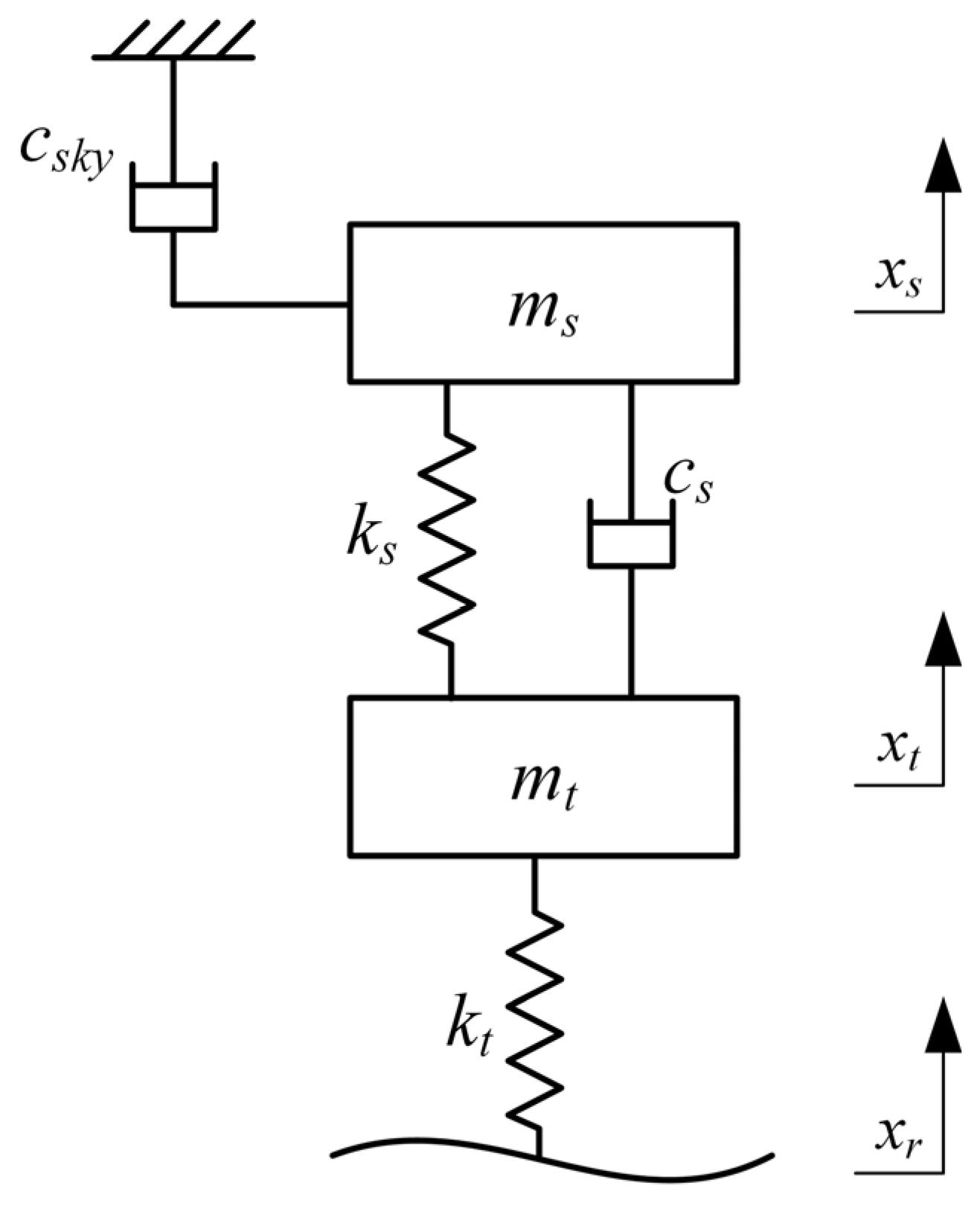

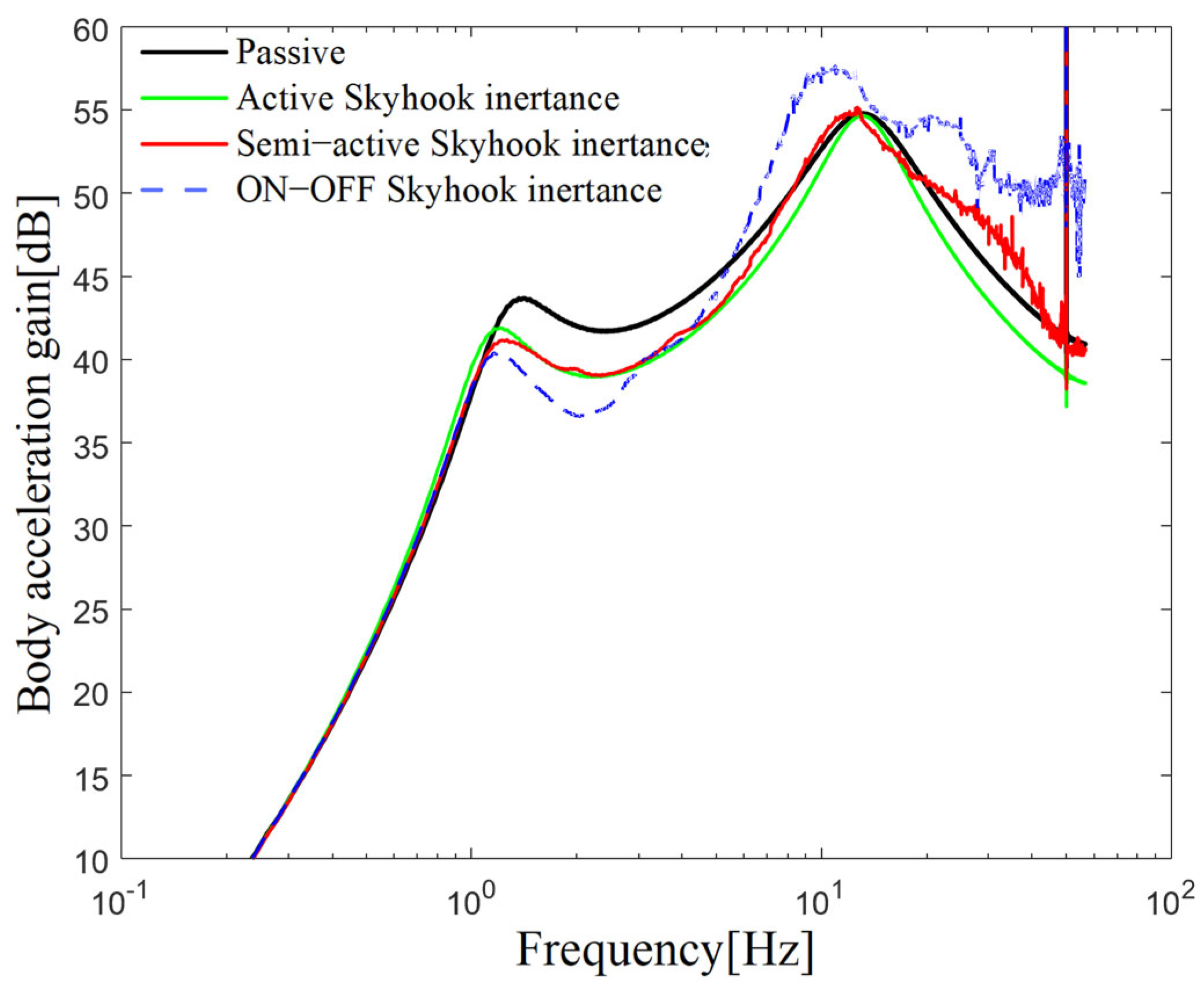
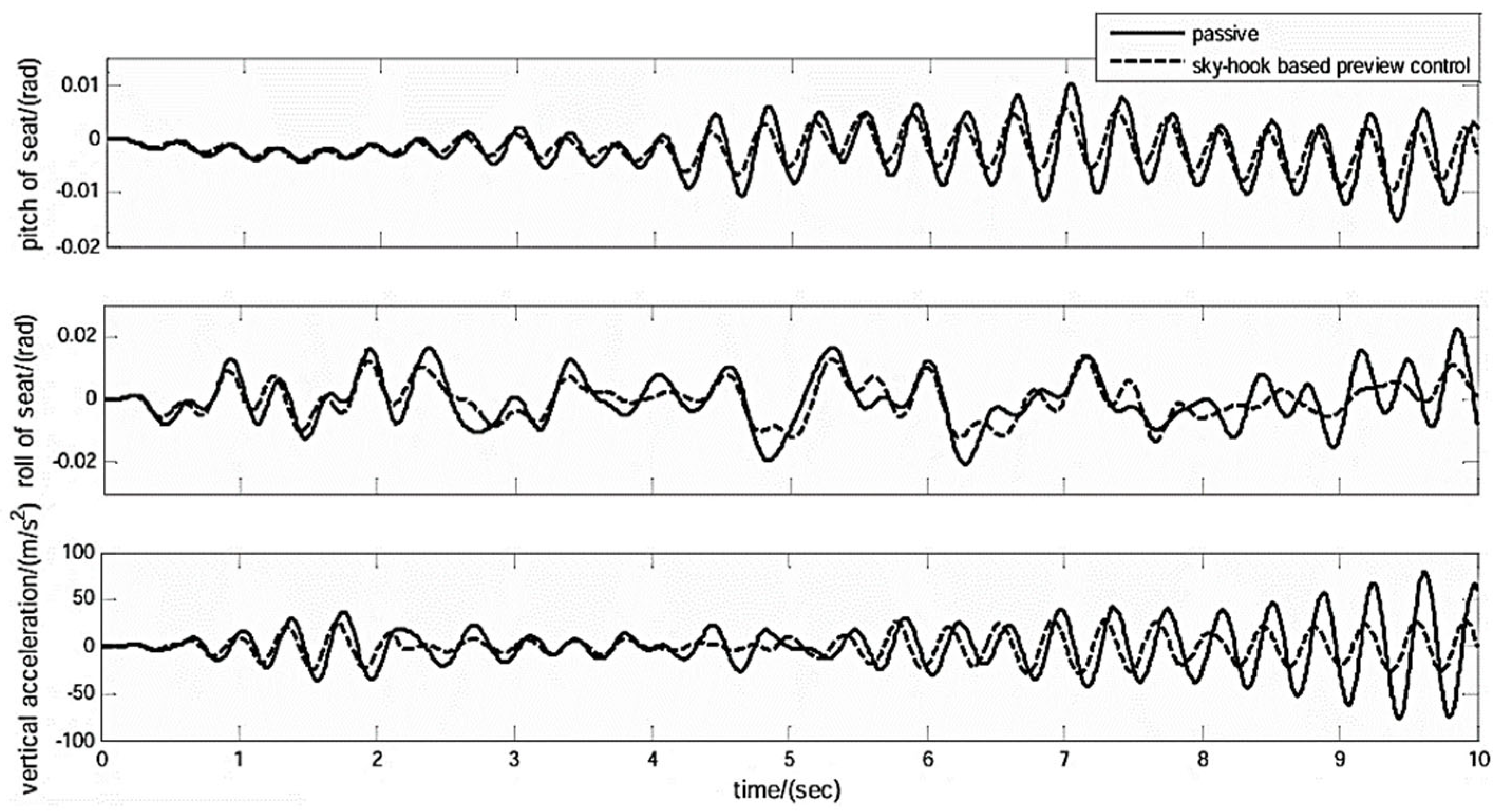

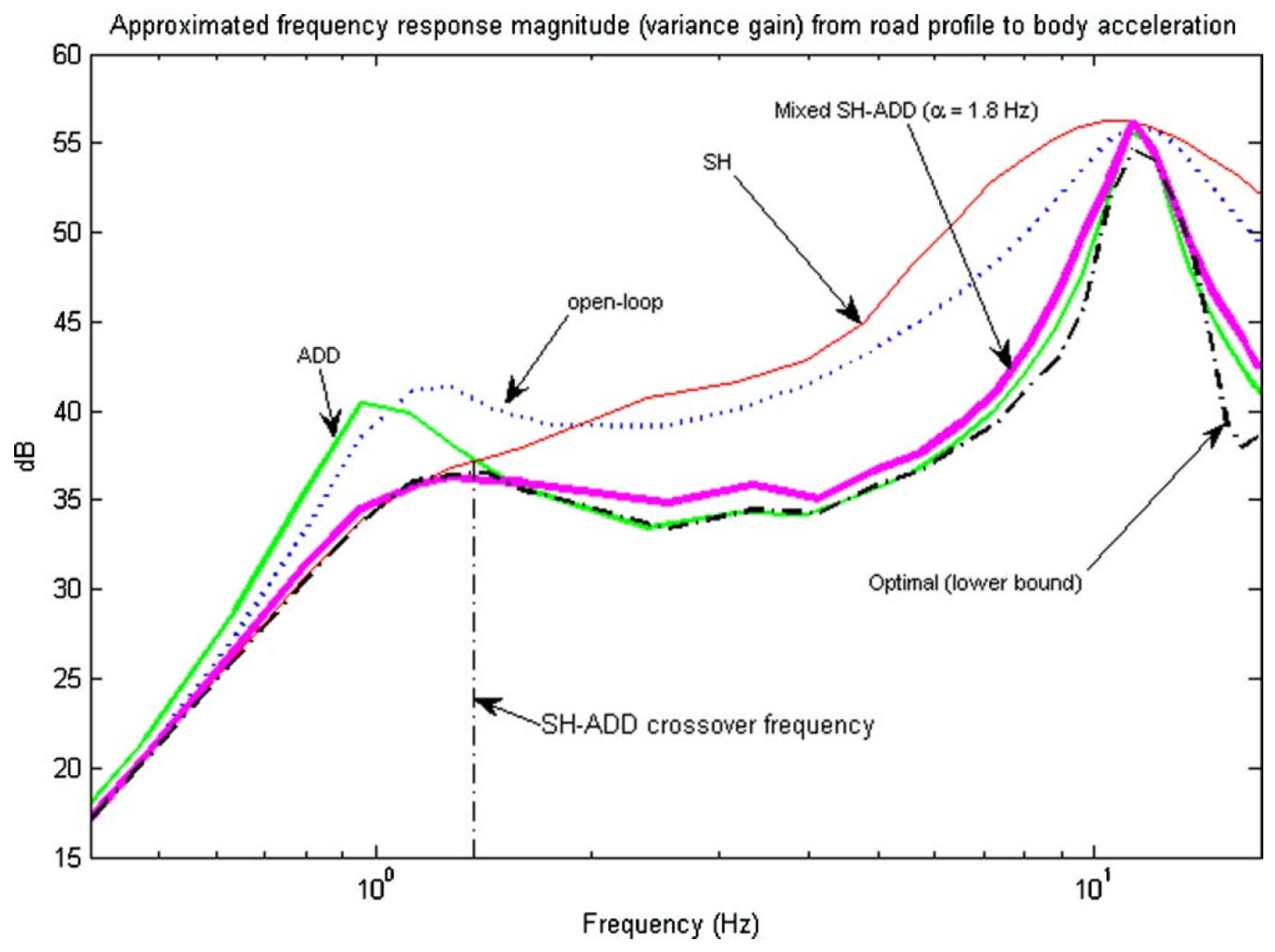
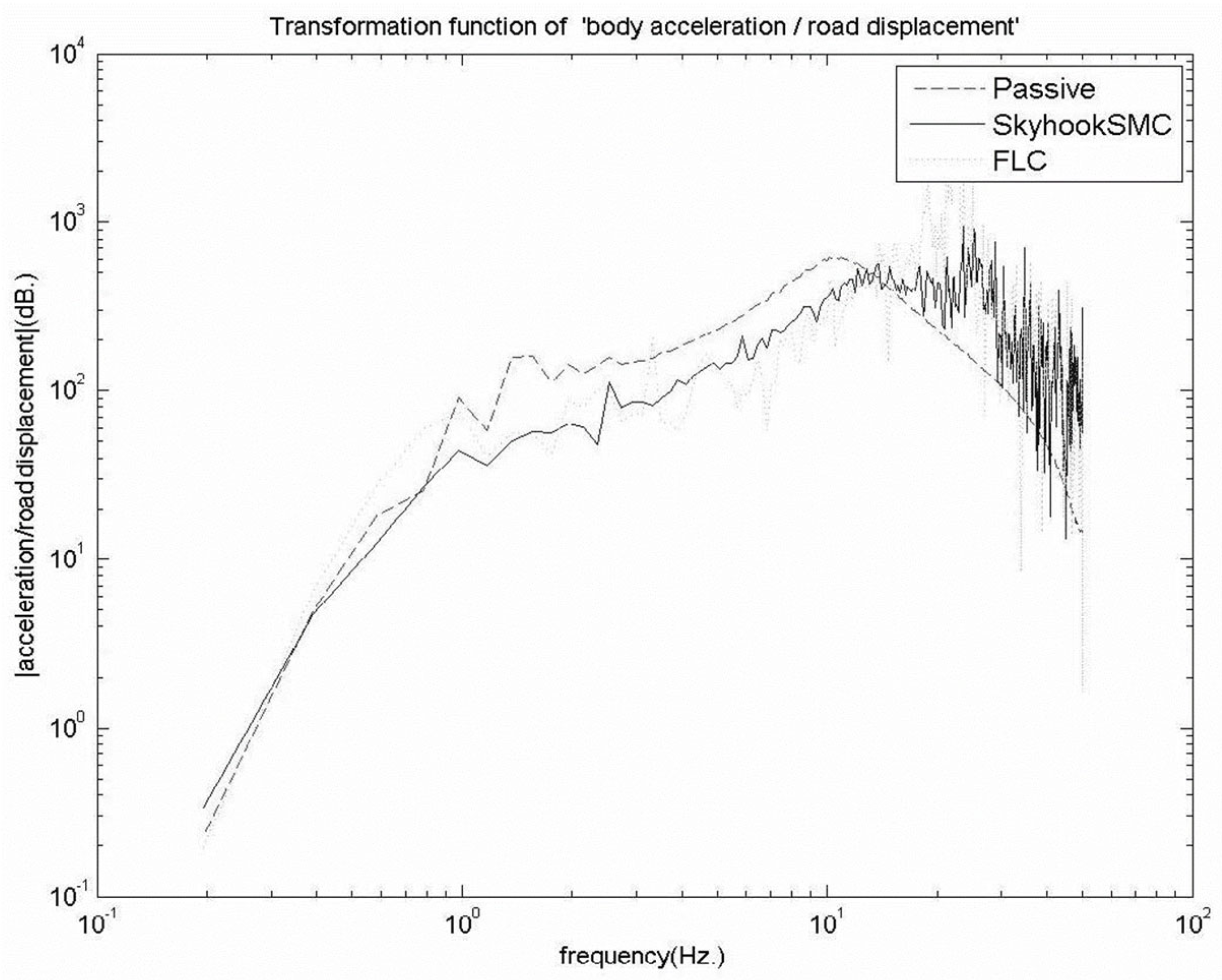
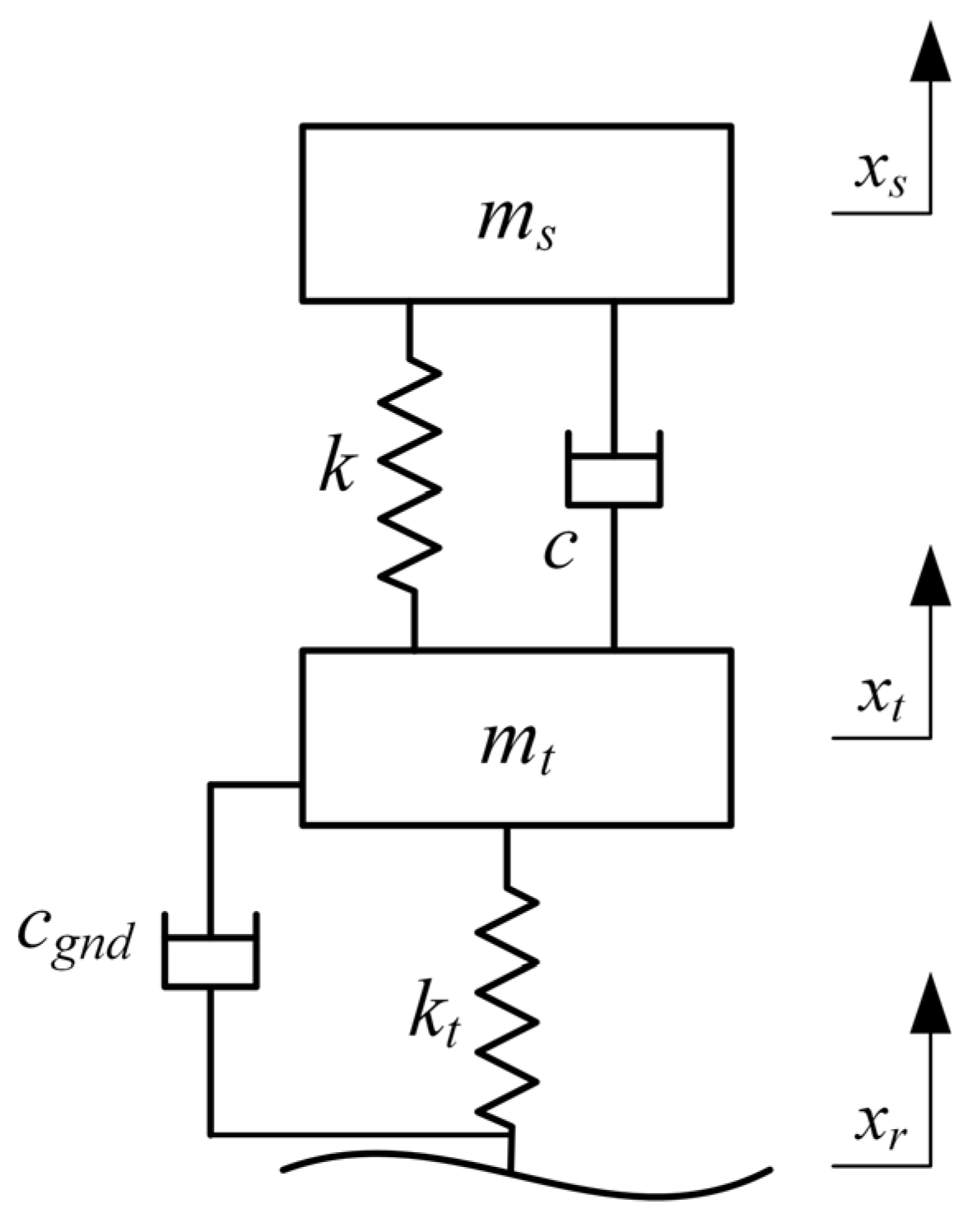
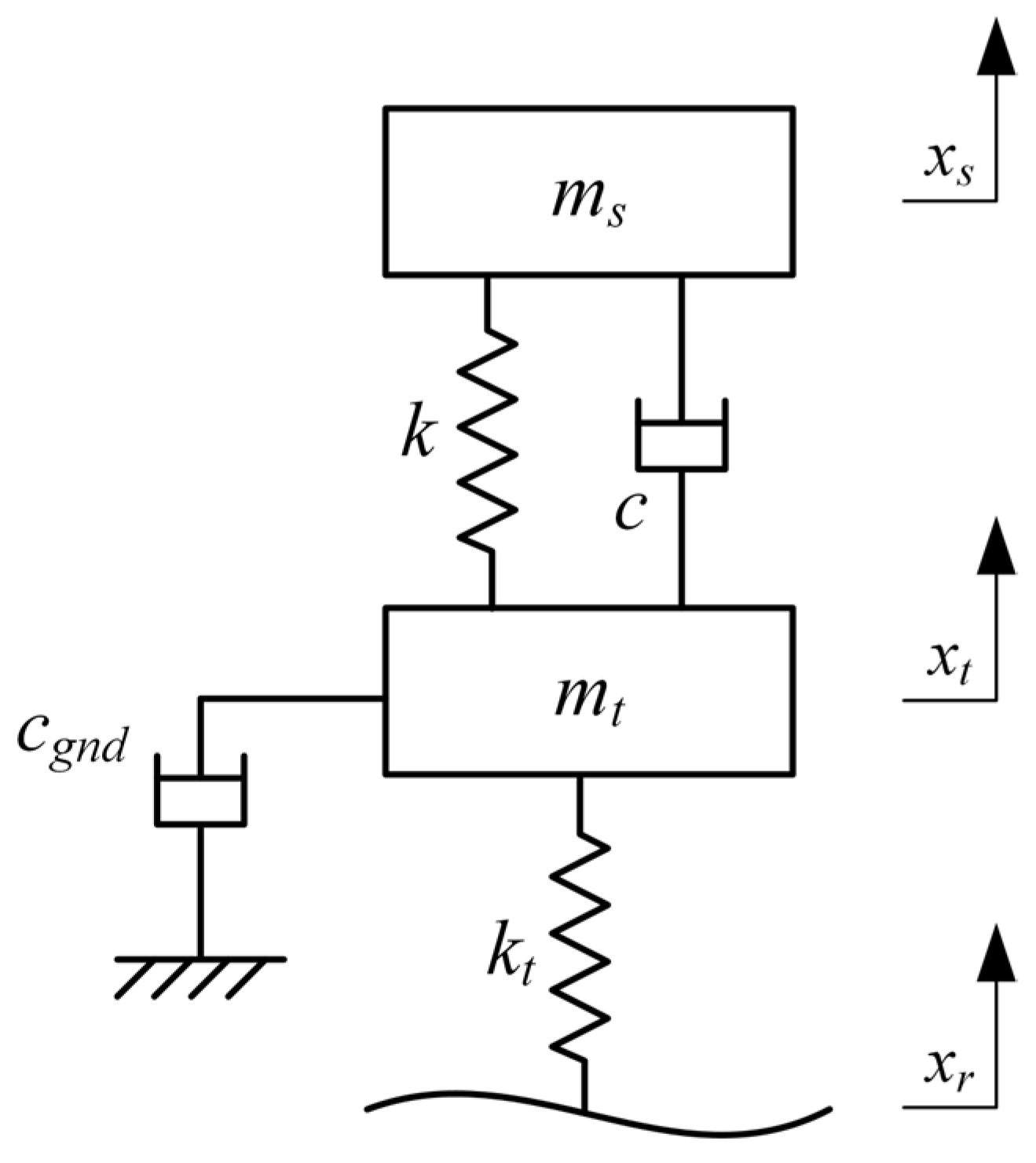

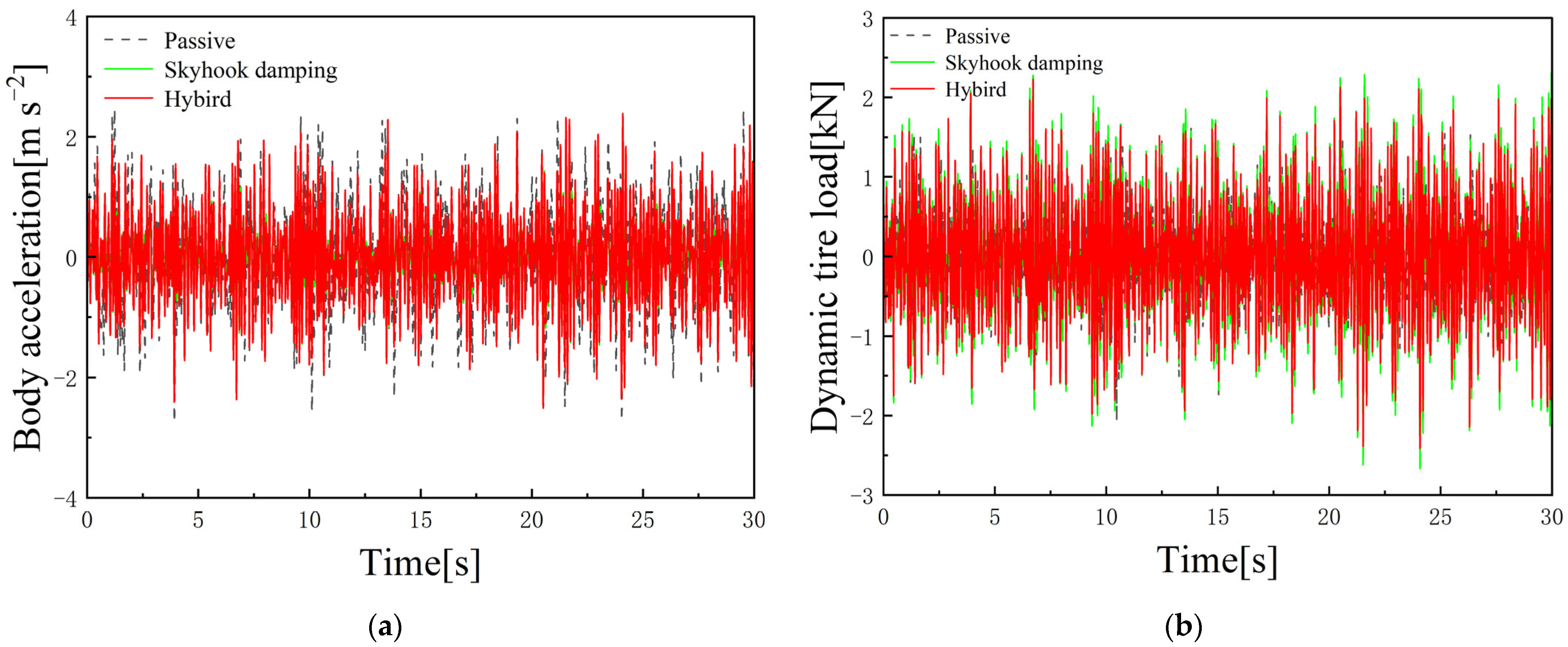

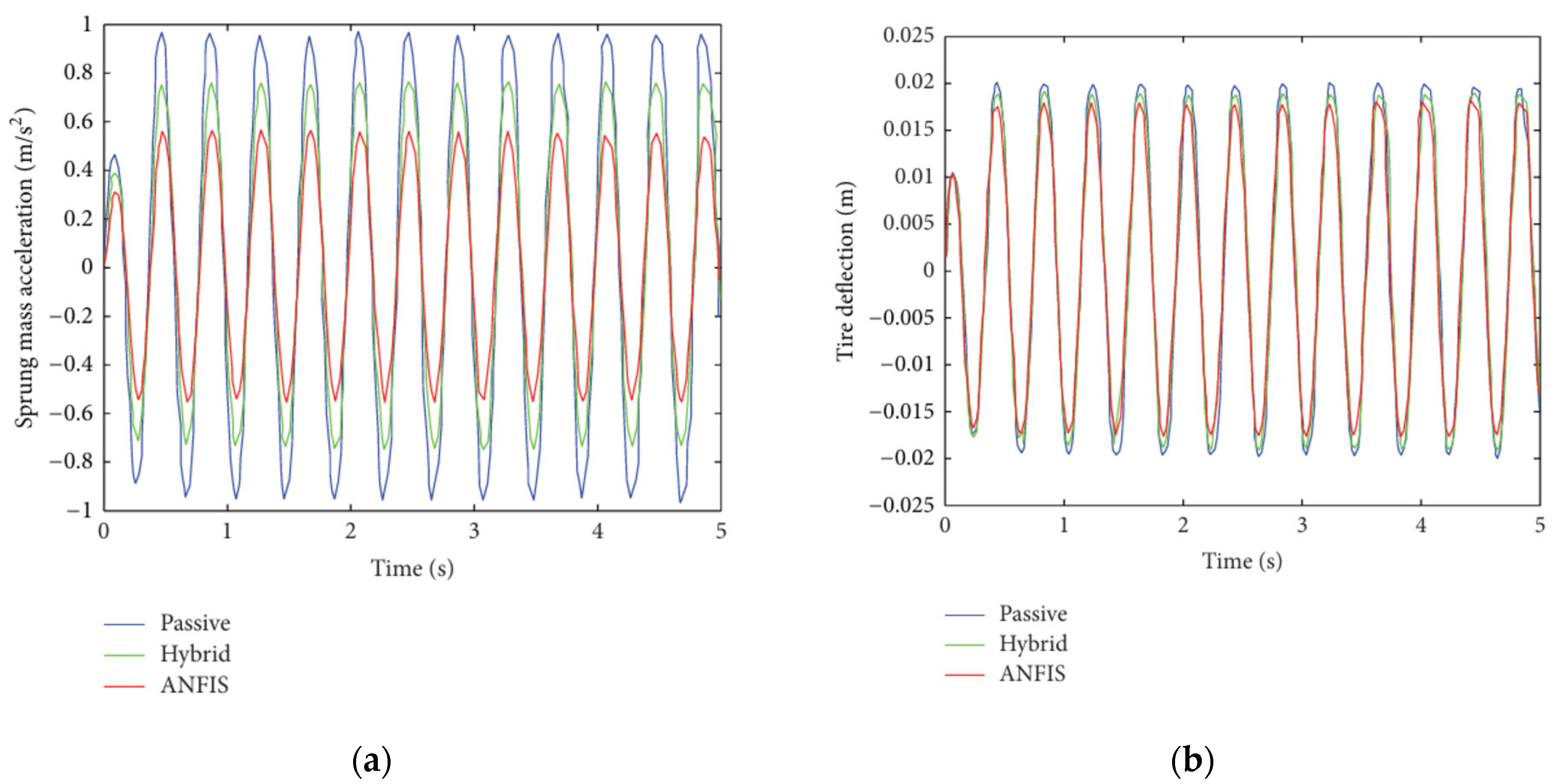
| Type | Principle and Function | Input | Application Model | Ref. |
|---|---|---|---|---|
| KF-Skyhook damping with railway suspensions | Kalman filter and Skyhook damping control are combined to design vertical and lateral control laws for railway suspension. | Body accel. | Railway vehicle | [43] |
| Adaptive Skyhook damping control law | The road condition is introduced into Skyhook damping control system, and filters are designed to observe road displacement, vehicle speed, and relative speed between vehicle body and wheel. | Body accel. | Macpherson suspension system: 1/4-car | [44] |
| Skyhook spring control | A spring is connected between the sky and a wheelset; it provides a control solution for the stability of railway wheelsets. | Wheel disp. | Railway vehicle | [45] |
| Skyhook and adaptive neuro active force control | Neural network (NN) based on an improved adaptive Levenberg–Marquardt learning algorithm is used to improve Skyhook control. | Body vel., wheel vel., suspension vel. | Semi-active 1/4-car | [46] |
| A Skyhook surface sliding mode control method | Improves Skyhook control by sliding mode control method of Skyhook surface. | Body vel., suspension vel. | Semi-active 1/4-car | [42] |
| Cost-effective Skyhook damping control | Reduces sensor placement, reduces cost, and improves system stability. | Body accel. | Semi-active 1/4 car | [47] |
| Mixed Skyhook and ADD (SH-ADD) | The Skyhook damping control and ADD control are divided into frequency control, so that the SH-ADD control method improves the smoothness in the whole frequency domain. | Body accel., body vel., suspension vel. | Semi-active 1/4 car | [48] |
| Fuzzy-Skyhook control | The rules of the fuzzy logic controller are tuned using the Skyhook control algorithm. | Body vel., suspension vel. | Semi-active 1/4 car | [49] |
| Skyhook control strategy based on preview control | Preview control with time-delay consideration was investigated by installing look-ahead sensor on front wheel. | Body vel., suspension vel., time-delay signal | Semi-active body-seat system | [32] |
| ID (inertial delay) Skyhook damping control | IDC is used to estimate the uncertainties as well as disturbances present in the system. | Body accel., body vel., wheel accel., wheel vel. | Active 1/4 car | [50] |
| Mixed SH and PDD (SH-PDD) | The algorithm defines a switching rule that can mix SH and PDD and exploit their advantages simultaneously. | Body vel., wheel vel., suspension vel., suspension disp. | Semi-active 1/4 car | [33] |
| Regenerative Skyhook damping control | Using the switched-mode rectifier (SMR), providing either a positive or negative damping ratio by controlling the electric current to alternate between regenerative and motoring modes. | Body vel., suspension vel. | Electromechanical suspension system | [51] |
| H∞-Skyhook damping control | H∞ control and Skyhook damping control are combined and applied to railway vehicles to improve driving safety and riding comfort. | Body vel.; wheel vel., disp.; suspension vel.; pitch rate, disp.; excitation vel., disp. | Active/semi-active 6 DOF vehicle model | [52] |
| Passive Skyhook damping suspension | Simplified the Skyhook damping system using the Routh stability criterion and Padé approximation technique. | -- | Passive 1/4 car | [53] |
| Energy-saving Skyhook control | A switch condition between active control and energy recovery is provided; the presented strategy coordinates the dynamic performance and energy consumption effectively. | Body vel., suspension vel. | Active 1/4 car | [54] |
| SH damping control with extended sliding innovation filter (ESIF) | Improvement of MR suspension system and Skyhook control using nonlinear estimation method—extended sliding innovation filter. | Body vel., suspension vel. | Semi-active 1/4 car | [55] |
| Skyhook-CDF algorithm | Used a cumulative distribution function (CDF) controller on suspension performance. | Body vel., suspension vel. | Semi-active 1/4 car | [38] |
| Skyhook sliding mode control | The SH-SMC control method used the ideal Skyhook controller as the reference and forced the tracking error dynamics between the plant and reference model, not the plant dynamics. | Body vel., disp.; road information vel., disp. | Seat suspension | [41] |
| Optimized fuzzy Skyhook damping control | The fuzzy Skyhook control method optimized by the grey wolf optimizer (GWO) algorithm was established. | Body vel., suspension vel. | Semi-active 1/4 car | [56] |
| Modified continuous Skyhook control | Considering the nonlinearity of stiffness characteristics, the Skyhook damping controller is improved. | Body vel., pitch rate, roll vel., suspension vel. | Semi-active full car | [57] |
| Gain-adaptive Skyhook-LQR control | Using LQR controller to solve the shortcomings of Skyhook control cannot improve rotational dynamics and provide a satisfactory coordinated control performance | Cabin vel., disp.; pitch rate, disp.; roll vel., disp.; suspension vel. | Cab-over-engine (COE) system | [58] |
| Proportional Skyhook damping control | An active Skyhook control strategy utilizing proportional-only control is proposed to calculate the desired control input to reduce the cabin’s local vertical velocity and thus improve ride comfort. | Body vel. | Suspension ship (WHzer-6) | [59] |
| CRONE Skyhook control | Fusion of vertical acceleration elimination control strategy and Skyhook damping control strategy. | Body accel. | Active 1/4 car | [60] |
| Skyhook-ADRC control | Applies extended state observer to implement switching control of ADRC and Skyhook and online estimation and compensation of disturbances such as road excitation. | Body accel. | Semi-active 1/4 car | [61] |
| Generalized Skyhook inertial suspension | The inerter is integrated into vehicle suspension system, and the ride comfort of vehicle is improved by using generalized Skyhook control theory. | Body vel., suspension vel. | Semi-active 1/4 car | [62] |
| Acquisition Method | State |
|---|---|
| Sensors | . |
| One operation | . |
| Two operations | . |
| Company | Damping System | Prototype | Application Model |
|---|---|---|---|
| ThyssenKrupp Bilstein | DampTronic ERS | 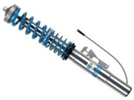 | BMW 7-Series; Nissan GT-R Nismo; Aston Martin DB11. |
| ZF Sachs | CDC |  | Audi A8; BMW 7-Series; Maserati 3200 Coupe; Porsche Cayenne. |
| Delphi | MagneRide |  | Cadillac Seville STS; Chevrolet Corvette; Audi TT, R8, and rs3. |
| Tenneco | CES |  | Volvo S60R, V70R, and S80; Cadillac Seville. |
Disclaimer/Publisher’s Note: The statements, opinions and data contained in all publications are solely those of the individual author(s) and contributor(s) and not of MDPI and/or the editor(s). MDPI and/or the editor(s) disclaim responsibility for any injury to people or property resulting from any ideas, methods, instructions or products referred to in the content. |
© 2025 by the authors. Licensee MDPI, Basel, Switzerland. This article is an open access article distributed under the terms and conditions of the Creative Commons Attribution (CC BY) license (https://creativecommons.org/licenses/by/4.0/).
Share and Cite
Wang, J.; Huang, Z.; Hong, H.; Yu, S.; Shi, W.; Zhang, X. Skyhook-Based Techniques for Vehicle Suspension Control: A Review of the State of the Art. Machines 2025, 13, 727. https://doi.org/10.3390/machines13080727
Wang J, Huang Z, Hong H, Yu S, Shi W, Zhang X. Skyhook-Based Techniques for Vehicle Suspension Control: A Review of the State of the Art. Machines. 2025; 13(8):727. https://doi.org/10.3390/machines13080727
Chicago/Turabian StyleWang, Jiyuan, Zhenxing Huang, Haodong Hong, Siyao Yu, Weihan Shi, and Xiaoliang Zhang. 2025. "Skyhook-Based Techniques for Vehicle Suspension Control: A Review of the State of the Art" Machines 13, no. 8: 727. https://doi.org/10.3390/machines13080727
APA StyleWang, J., Huang, Z., Hong, H., Yu, S., Shi, W., & Zhang, X. (2025). Skyhook-Based Techniques for Vehicle Suspension Control: A Review of the State of the Art. Machines, 13(8), 727. https://doi.org/10.3390/machines13080727






